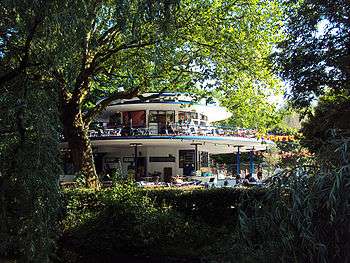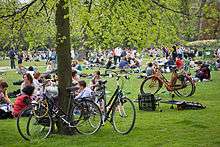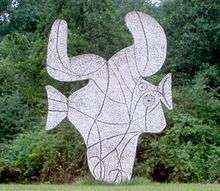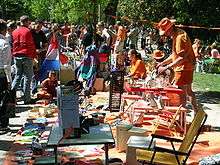Vondelpark
| Vondelpark | |
|---|---|
|
People relaxing near a pond in the Vondelpark | |
| Type | Urban park |
| Location | Amsterdam, Netherlands |
| Area | 47 ha (120 acres) |
| Created | 1865 |
| Operated by | Amsterdam-Zuid |
| Visitors | 10 million[1] |
| Status | Open all year |
Coordinates: 52°21′29″N 4°52′05″E / 52.358°N 4.868°E
The Vondelpark is a public urban park of 47 hectares (120 acres) in Amsterdam, Netherlands. It is part of the borough of Amsterdam-Zuid and situated west from the Leidseplein and the Museumplein. The park was opened in 1865 and originally named the "Nieuwe Park", but later renamed to "Vondelpark", after the 17th-century playwright and poet Joost van den Vondel. Yearly, the park has around 10 million visitors. In the park is an open-air theatre, a playground and several horeca facilities.
History
19th century


In 1864 a group of citizens led by Christiaan Pieter van Eeghen established the Vereeniging tot Aanleg van een Rij- en Wandelpark (English: Association for the Construction of a Park for Riding and Strolling). They bought several hectares of grass-land and marshes at the rim of the city of Amsterdam, in order to create the new park. They assigned the architect Jan David Zocher to design it, and in 1865 "Het Nieuwe Park" (English: "The New Park") was opened for members of the association and in exchange for a fee also for other citizens.[2]
Two years after the park opened, in 1867, a statue of writer and playwright Joost van den Vondel was placed in the park. Sculptor Louis Royer created the sculpture and the architect Pierre Cuypers designed the stand.[2] As a result, people started to call the park "Vondelspark" (English: "Vondel's Park").[3]
In 1873 a bandstand was built. In the same year, brewer Gerard Adriaan Heineken was denied to open a bar in the park, so he built the Bierhuis Vondel (English: "Beer House Vondel") in the street next to the park, what is now Vondelstraat 41.[2]
The last part of the park was designed by Louis Paul Zocher, Jan David Zocher's son, and was realized from 1875 to 1877.[4] The park now became its current size of 47 hectares. Also the English garden style design of the Zochers has been roughly maintained up to now, although in the late 19th century the elongated park had a stream of water from the beginning to the end and contained many small paths and small bushes.[3]
In 1878 the Pavillon (English: "Pavilion") was built as a replacement of a wooden chalet built by Louis Paul Zocher. The Pavillon is currently known as the Vondelparkpaviljoen (English: "Vondelpark Pavilion"). The park's name was officially changed into "Vondelpark" (English: "Vondel Park") in 1880.[2]
Already in the 1880s and 1890s the cycling in the park caused hindrance. First the park management tried to resolve this with restrictive measurements against cyclists, such as special bike paths, limited opening hours, and fines for cyclists that were going faster than a horse's trot. It was only after mediation of the Algemene Nederlandsche Wielrijders-Bond (English: "General Dutch Cyclists Union"), that helped fund the park, that a park guard was installed and cyclists were again permitted to cycle normally.[2]
20th century

In 1936, a rose garden was created in the center of the park.[3]
One year later in 1937, the Blauwe Theehuis (English: "Blue Tearoom") was opened. This tearoom is a round modernist building, designed by the architectural office Baanders.[5]
In the following years the overall maintenance of the park became too expensive for the Vereniging tot aanleg van een rij- en wandelpark (English: "Association for the creation of a park for riding and strolling"), due to an intensified use, and in 1953 the association donated the park to the city of Amsterdam. The landscape architect Egbert Mos renovated the Vondelpark for the city in the 1950s. The purpose was improve the park for both usage and maintenance. Small bushes were grouped into larger bushes, superfluous paths were removed, and the rose garden was renovated. Also the stream of water in the "trunk" near the northern entrance of the park was removed.[3]
In the 1960s children's playgrounds were created. During the flower power era in the 1960s/1970s the Vondelpark became a symbol of a place where "everything is possible and (almost) everything is allowed".[6] In the 1980s an open-air theatre was built.[3]
The Vondelpark received the status of rijksmonument (English: "state monument") in 1996.[3]
21st century

In the 1990s the number of visitors grew to approximately 10 million visitors annually. The grass is used as sports field and the paths as bike paths. This caused the city to start a new renovation that takes place from 1999 to 2010. The purpose is to intensify the monumental value of the park and furthermore to improve the park's durability. The renovation takes more than ten years in order to decrease the hindrance for visitors and for brooding animals.[7]
Starting in September 2008, adults were planned to be legally allowed to have sex in the park,[8] as long as they "take their garbage with them afterwards and never have intercourse near the playground. The sex must be limited to the evening hours and night.", in the words of current Amsterdam Alderman Paul Van Grieken.[9] However, Amsterdam Police announced that they would not in fact tolerate this, as the law required them to prevent it.
Facilities
Open-air theatre
The Vondelpark Openluchttheater is an open-air theatre with shows from June until August. There are performances of classical music, pop music, world music, dance, musical theatre, and cabaret. The theatre receives a subsidy from the city government. And although all performances have free entrance, visitors are asked for a donation of one euro.[10]
Horeca
And in the park are several horeca facilities (listed in alphabetical order):
- 't Blauwe Theehuis, a bar/restaurant[11]
- Groot Melkhuis, a bar/restaurant[12]
- Vondeling, the bar/restaurant of the open-air theatre[10]
- Vondeltuin, a bar/restaurant[13]
Statues

There are some statues in the park:
- Joost van den Vondel (1867) by Louis Royer[2]
- The Fish (1965) by Pablo Picasso[5]
- Mama Baranka (1985) by Nelson Carrilho[14]
Events

Every Friday there is the Fridaynightskate that starts in front of the Filmmuseum.
Yearly events include the golf tournament Vondelpark Open and the running contest Vondelparkloop.
The King's Day celebrations on 27 April in the Vondelpark focus specifically on children. There is a "freemarket" (Dutch: vrijmarkt) and there are games and other activities for children.
From June until August there are music and dance performances in the open-air theatre.
Since 2011 on the evening of All Soul's Day people gather and float many small "remembrance" boats with a lighted candle in the big pond to remember those who have died in the last year(s).
Popular culture
The park is referenced in Acda en De Munnik's song "Vondelpark vannacht" from the album Acda en De Munnik (1997) and in Omar Rodríguez-López's song "Vondelpark bij nacht" from the album Omar Rodriguez (2005). 1990s' 2009 album 'Kicks' opens with a track entitled "Vondelpark", which is a tour diary from one of the band's trips to the Netherlands. The English dream pop band Vondelpark took their name from the park. The Vondelpark is also briefly mentioned in John Green's 2012 novel The Fault in Our Stars.
Canon of Amsterdam
- Vondelpark and Museumplein is window number 29 in the Canon of Amsterdam.
References
- ↑ "The Vondelpark". www.oudzuid.amsterdam.nl. Government of Amsterdam. Retrieved 2008-05-07. External link in
|work=(help) - 1 2 3 4 5 6 "Chronologie van de 19e eeuw" (in Dutch). Vereniging Vrienden van het Vondelpark. Retrieved 2008-05-07.
- 1 2 3 4 5 6 "Geschiedenis". www.oudzuid.amsterdam.nl (in Dutch). Government of Amsterdam. Retrieved 2008-05-06. External link in
|work=(help) - ↑ Plan for the expansion of the Vondelpark by J.D. and L.P. Zocher at the Amsterdam City Archives
- 1 2 "Chronologie van de 20e eeuw" (in Dutch). Vereniging Vrienden van het Vondelpark. Retrieved 2008-05-07.
- ↑ Documentation regarding hippies sleeping in the Vondelpark at the Amsterdam City Archives
- ↑ "Renovatie: 1999 - 2010". www.oudzuid.amsterdam.nl (in Dutch). Government of Amsterdam. Retrieved 2008-05-06. External link in
|work=(help) - ↑ Quirky News from Ananova
- ↑ "Public sex fine, roaming dogs not". The Daily Telegraph. 2008-03-11.
- 1 2 "Vondelpark Openluchttheater" (in Dutch). Vondelpark Openluchttheater. Retrieved 2008-05-07.
- ↑ "'t Blauwe Theehuis" (in Dutch). 't Blauwe Theehuis. Retrieved 2008-05-07.
- ↑ "Groot Melkhuis" (in Dutch). Groot Melkhuis. Retrieved 2008-05-07.
- ↑ "Vondeltuin" (in Dutch). Vondeltuin. Retrieved 2008-05-07.
- ↑ "Mama Baranka" (in Dutch). Nelson Carrilho. Retrieved 2008-05-07.
External links
| Wikimedia Commons has media related to Vondelpark. |
- (Dutch) Vondelpark
- Satellite View from Google Maps
- Archive of the Vondelpark society at the Amsterdam City Archives
